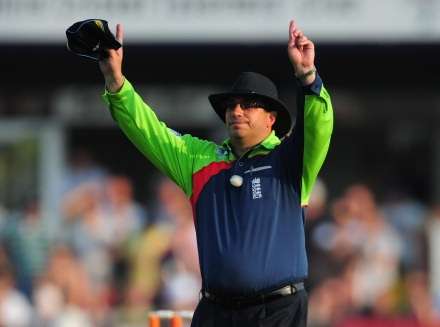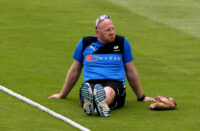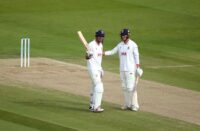Neil Bainton, in his tenth season as a first-class umpire, reveals to Rob Johnstone that the growth of T20 means the pressure is now greater than ever
Neil Bainton was in his late teens when, playing for his club’s third XI, he realised that he enjoyed the umpiring stints that the players had to share between themselves when they batted more than he did playing the game. Soon after, he decided to give up playing altogether and see how far he could take his umpiring.
Bainton, now 45, is in his tenth year on the ECB’s first-class umpires’ list having risen through the Essex League and county second XI ranks. He is one of 25 first-class umpires, assisted by eight umpires on the ECB’s reserve list, who officiate at first-class and county second XI fixtures during the summer.
County umpires are vital to the smooth running of the professional game yet operate in the background, which is perhaps as it should be: umpires making news usually means something has gone wrong.
The current set of umpires are well regarded for their ability and the relationship between the players and officials is generally excellent.
“Getting on with the players and player-management is key to being a good umpire at this level, as is not being too officious,” Bainton says. “It’s the players’ game and you’ve just got to be accepted into their group. If you can do that, as long as you’re giving the correct decisions most of the time, that will help.”
The full list is a mix of former first-class players and those, like Bainton, who did not play professionally. “A lot of the former players who umpire have that respect immediately from the current players,” says Bainton. “For the non-players, it’s harder to get that respect but you do get accepted quite quickly. If you’ve progressed to that level the players obviously feel that you’re good enough.”
Each umpire on the panel has a 12-month contract – although some will have other jobs during the winter – and this season they are required for 91 days of cricket including third umpire and second XI duties. Any days above this and they get paid overtime. In all, Bainton reckons that he will spend at least 80 days away from home during this season.
“They try and keep us closer to home with the appointments, certainly if you’re doing second XI matches,” he says. “They try to avoid long distances between matches too so you wouldn’t be sent from Durham to Somerset and be meant to start the next day.
“Sometimes it’s not ideal because you can go from a floodlit game finishing at 10.30 in the evening and very occasionally you will be on the field the next day at 11 o’clock. That’s not the norm but sometimes it cannot be avoided if umpires get injured and you’re called in for extra games.
“There will be times when you can’t go home after a game such as if you were to do a four-day game at Durham, have a day off and then have a one-day game at Manchester. It’s not worth driving all the way back so that’s not a day as part of the 91 but is a day when you’re away from home.”
The development of T20 cricket and the rewards on offer has meant an already pressurised job has become even more so. A wrong decision can impact the outcome of a T20 game much more than in a longer format, so never has it been more critical for the right decisions to be made.
“The T20 has now become very serious and a no-ball here or there for example can make a hell of a difference with free-hits,” he says.
“For the players, it’s the biggest tournament in front of the biggest crowds so everything has been heightened by that, including for umpires. Certainly the balls are getting hit harder and you might be umpiring a few feet further back than you would normally be. I was at Canterbury last week (for a T20) and there were times where the ball was flying around and it was coming back at a rate of knots.”
To assist the standing umpires, the third-umpire duties have expanded to check on front-foot no-balls if a wicket falls and to get involved if a ball is possibly a high full toss. Umpiring is very much a three-way effort these days.
As befits professional officials, preparation is wide-ranging and thorough. Before this season, the first-class umpires undertook workshops on the Laws of the game and the ECB’s playing regulations, which are different to the Laws, as well as fitness testing, third-umpire work and anti-corruption training.
For the first time they were also given first-aid training, including giving the dressing room a signal if a player is unconscious on the field so a defibrillator can be brought out. With the recent retirement of James Taylor due to a heart condition and the shocking death of Phillip Hughes in 2014, umpires are wisely being prepared to do their bit should the unthinkable happen.
As with players, the umpires’ preparation is geared towards performance on the pitch. Each umpire is evaluated after each county game by both captains and, if present, one of the four ECB Cricket Liaison Officers. Consistently good marks leads to bigger games, including finals, and potentially elevation to international level.
Umpiring at the highest level is a genuine option for those county umpires ambitious and good enough. English umpires are among the best trained and performing in the world. The ICC’s 12-man Elite Panel includes four English umpires – more than any other country – and Yorkshire’s Richard Kettleborough is the current ICC Umpire of the Year.
Umpires are often a forgotten part of the county system, only noticed when a mistake is made, and relied upon to be at the top of their game for every ball of every match.
The pressure on them is great but they are well-prepared professionals doing, on the whole, a fine job for English cricket. They are pretty lucky too: after all, they have been given the best view in the house.
This piece originally featured in The Cricket Paper, Friday June 3 2016












